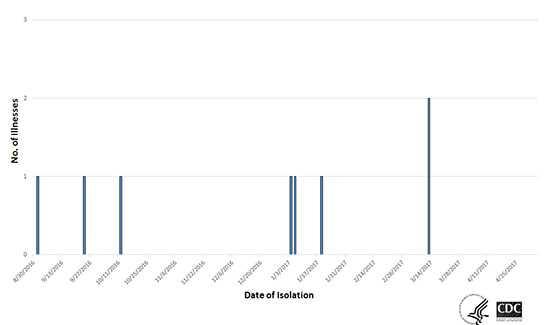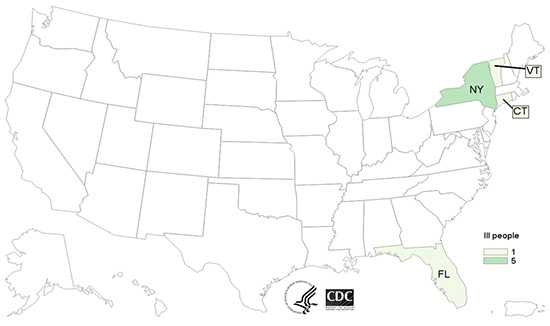Multistate Outbreak of Listeriosis Linked to Soft Raw Milk Cheese Made by Vulto Creamery (Final Update)
Posted May 3, 2017 1:30 PM ET
This outbreak appears to be over. However, Listeria remains an important cause of serious, life-threatening human illness in the United States. For more information about Listeria and steps that people can take to reduce their risk of infection, visit CDC’s Listeria webpage.
Highlights
- Read the Recall & Advice to Consumers and Retailers>>
- This outbreak appears to be over. However, CDC recommends that consumers do not eat, restaurants do not serve, and retailers do not sell recalled raw milk cheeses made by Vulto Creamery.
- On March 10, 2017, Vulto Creamery recalled all lots of its raw milk cheeses.
- The raw milk cheeses were distributed nationwide, with most being sold at retail locations in the northeastern and Mid-Atlantic states; California; Chicago; Portland, Oregon; and Washington, D.C.
- CDC, public health and regulatory officials in several states, and the U.S. Food and Drug Administration (FDA) investigated a multistate outbreak of Listeria monocytogenes infections (listeriosis).
- Eight people infected with the outbreak strain of Listeria were reported from four states.
- All eight people were hospitalized, including two people from Connecticut and Vermont who died. One illness was reported in a newborn.
- Epidemiologic and laboratory evidence indicated that soft raw milk cheese made by Vulto Creamery of Walton, New York, was the likely source of this outbreak.
Outbreak Summary
Introduction
CDC collaborated with public health and regulatory officials in several states and the U.S. Food and Drug Administration (FDA) to investigate a multistate outbreak of Listeria monocytogenes infections (listeriosis). Listeria causes a serious, life-threatening illness.
Public health investigators used the PulseNet system to identify illnesses that were part of this outbreak. Eight people infected with the outbreak strain of Listeria were reported from four states. Since the initial announcement on March 9, two more ill people were reported from New York. A list of states and the number of cases in each can be found on the Case Count Map page. Whole genome sequencing (WGS) performed on clinical isolates from all eight ill people showed that the isolates were closely related genetically. This close genetic relationship provided additional evidence that people in this outbreak became ill from a common source.
Listeria specimens from ill people were collected from September 1, 2016 to March 13, 2017. Ill people ranged in age from less than one year to 89 years, with a median age of 52 years. Five of eight ill people were female. All eight (100%) ill people were hospitalized, including two people from Connecticut and Vermont who died. One of the illnesses was reported in a newborn.
Investigation of the Outbreak
Epidemiologic and laboratory evidence indicated that soft raw milk cheese made by Vulto Creamery of Walton, New York, was the likely source of this outbreak.
State and local health departments interviewed ill people or their family members about the foods they ate or other exposures in the month before their illness started. Based on those interviews, eight (100%) of eight people ate a soft cheese. The ill resident of Florida reported traveling to New York state and eating soft cheese there before becoming ill. Available information indicated that cheese made by Vulto Creamery was for sale at stores where at least seven of the ill people bought cheese before getting sick.
The Connecticut Department of Public Health collected leftover cheeses from the home of the deceased person in Connecticut. The outbreak strain of Listeria was identified in a leftover cheese that the family identified as Ouleout cheese from Vulto Creamery.
The New York Division of Milk Control and Dairy Services collected three intact wheels of Ouleout cheese from Vulto Creamery. The outbreak strain of Listeria was identified in samples taken from the three wheels of cheese. On March 7, 2017, Vulto Creamery recalled all lots of Ouleout, Miranda, Heinennellie, and Willowemoc soft wash-rind raw milk cheeses. On March 10, the company expanded the recall to include four other cheeses: Andes, Blue Blais, Hamden, and Walton Umber. The raw milk cheeses were distributed nationwide, with most sold in stores in the northeastern and Mid-Atlantic states; California; Chicago; Portland, Oregon; and Washington, D.C.
This outbreak appears to be over. However, CDC recommends that consumers do not eat, restaurants do not serve, and retailers do not sell recalled raw milk cheeses made by Vulto Creamery.
March 9, 2017
Initial Announcement
CDC is collaborating with public health and regulatory officials in several states, and the U.S. Food and Drug Administration (FDA) to investigate a multistate outbreak of Listeria monocytogenes infections (listeriosis). Listeria can cause a serious, life-threatening illness.
Public health investigators are using the PulseNet system to identify illnesses that may be part of this outbreak. PulseNet is the national subtyping network of public health and food regulatory agency laboratories coordinated by CDC. DNA “fingerprinting” is performed on Listeria bacteria isolated from ill people by using techniques called pulsed-field gel electrophoresis (PFGE) and whole genome sequencing (WGS). CDC PulseNet manages a national database of these DNA fingerprints to identify possible outbreaks. WGS gives a more detailed DNA fingerprint than PFGE.
Six people infected with the outbreak strain of Listeria have been reported from four states since September 1, 2016. A list of states and the number of cases in each can be found on the Case Count Map page. WGS performed on clinical isolates from all six ill people shows that the isolates are closely related genetically. This close genetic relationship provides additional evidence that people in this outbreak became ill from a common source.
Listeria specimens from ill people were collected from September 1, 2016 to January 22, 2017. Ill people range in age from less than one year to 89 years, with a median age of 55. Five of six ill people are female. All six (100%) ill people reported being hospitalized, and two people from Connecticut and Vermont died. One of the illnesses was reported in a newborn.
The outbreak can be illustrated with a chart showing the number of people who were diagnosed each week. This chart is called an epidemic curve or epi curve.
Investigation of the Outbreak
Epidemiologic and laboratory evidence indicates that soft raw milk cheese made by Vulto Creamery of Walton, New York, is the likely source of this outbreak.
State and local health departments interviewed ill people or their family members about the foods they may have eaten or other exposures in the month before their illness started. Six (100%) of six people reported eating a soft cheese. The ill resident of Florida reported traveling to New York State and eating soft cheese there before becoming ill. Available information indicates that cheese made by Vulto Creamery was for sale at stores where at least five of the ill people purchased cheese before becoming ill.
The Connecticut Department of Public Health collected leftover cheeses from the deceased person’s home in Connecticut. The outbreak strain of Listeria was identified in a leftover cheese that the family identified as Ouleout cheese from Vulto Creamery.
The New York Division of Milk Control and Dairy Services collected three intact wheels of Ouleout cheese from Vulto Creamery during a joint inspection with FDA. The outbreak strain of Listeria was identified in samples taken from the three wheels of cheese. On March 7, 2017, Vulto Creamery recalled all lots of Ouleout, Miranda, Heinennellie, and Willowemoc soft wash-rind raw milk cheeses. The soft raw milk cheeses were distributed nationwide, with most being sold at retail locations in the northeastern and Mid-Atlantic States, California, Chicago, Portland, Oregon, and Washington, D.C.
CDC and state and local public health partners are continuing laboratory surveillance through PulseNet to identify additional ill people and to interview them. This investigation is ongoing, and updates will be provided when more information is available.
More Information:
- Page last reviewed: March 9, 2017
- Page last updated: May 3, 2017
- Content source:


 ShareCompartir
ShareCompartir


